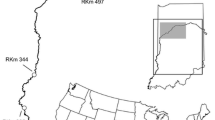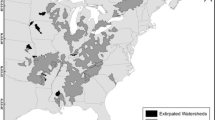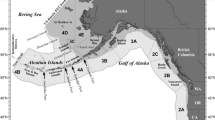Abstract
Knowledge of the movement behaviour and dispersal ability of non-native species can aid in their management by informing risk assessments and the development of control strategies. To improve understanding of the seasonal movement and dispersal behaviour of Northern Snakehead (Channa argus), we implanted 49 fish in the Potomac River with radio tags and tracked movements from October 2006 to 2007. In addition, we tested the hypotheses that activity level, dispersal ability, and home range size varied with fish size. Home range was calculated for 24 fish. Of these, 19 exhibited stable home ranges averaging 1.2 km2 in size. Thirteen fish (31% of survivors) dispersed an average distance of 18 km between 30 April and 7 June, mostly upstream (92%) and across the main river channel. Fish moved greater distances during the pre-spawn season compared to the spawning season. There was no relationship between fish length and any behavioural measure. Upstream dispersal was restricted by barriers such as dams; therefore, Northern Snakehead can likely disperse greater distances than observed here. Our observations demonstrate the invasiveness of Northern Snakehead by showing that a large portion of adults dispersed over considerable distances, suggesting spread may be rapid in large, open freshwater systems.




Similar content being viewed by others

References
Burnet, A. M. R., 1969. The growth of New Zealand freshwater eels in three Canterbury streams. New Zealand Journal of Marine and Freshwater Research 3: 376–384.
Courtenay, W. R. J. & J. D. Williams, 2004. Snakeheads (Pisces, Channidae)—a biological synopsis and risk assessment. US Geological Survey Circular 1251, Gainesville, FL.
Crook, D. A., 2004. Is the home range concept compatible with the movements of two species of lowland river fish? Journal of Animal Ecology 73: 353–366.
Daehler, C. C., 2001. Two ways to be an invader, but one is more suitable for ecology. Bulletin of the Ecological Society of America 82: 101–102.
Daugherty, D. J. & T. M. Sutton, 2005. Seasonal movement patterns, habitat use, and home range of flathead catfish in the lower St. Joseph River, Michigan. North American Journal of Fisheries Management 25: 256–269.
Duckworth, R. A. & A. V. Badyaev, 2007. Coupling of dispersal and aggression facilitates the rapid range expansion of a passerine bird. Proceedings of the National Academy of Sciences of the United States of America 104: 15017–15022.
Fuller, P. F., A. J. Benson & M. E. Neilson, 2012. Channa argus, Gainesville, FL. http://nas.er.usgs.gov/queries/FactSheet.aspx?speciesID=2265. Revision 3 Sept 2012. Accessed on 27 July 2012.
García-Berthou, E., 2007. The characteristics of invasive fishes: what has been learned so far? Journal of Fish Biology 71: 33–55.
Gascho Landis, A. M. & N. W. R. Lapointe, 2010. First record of a Northern Snakehead (Channa argus Cantor) nest in North America. Northeastern Naturalist 17: 325–332.
Gascho Landis, A. M., N. W. R. Lapointe & P. L. Angermeier, 2011. Individual growth and reproductive behavior in a newly established population of Northern Snakehead, Potomac River, USA. Hydrobiologia 661: 123–131.
Guseva, L. N., 1990. Food and feeding ratios of the Amur Snakehead, Channa argus warpachowskii, in water bodies in the lower reaches of the Amu Darya. Journal of Ichthyology 3: 11–21.
Harrison, S. & A. D. Taylor, 1997. Empirical evidence for metapopulation dynamics. In Hanski, I. A. & M. E. Gilpin (eds), Metapopulation biology: ecology, genetics, and evolution. Academic Press, San Diego, CA: 27–42.
Herborg, L. M., N. E. Mandrak, B. C. Cudmore & H. J. Maclsaac, 2007. Comparative distribution and invasion risk of snakehead (Channidae) and Asian carp (Cyprinidae) species in North America. Canadian Journal of Fisheries and Aquatic Sciences 64: 1723–1735.
Jelks, H. L., S. J. Walsh, N. M. Burkhead, S. Contreras-Balderas, E. Diaz-pardo, D. A. Hendrickson, J. Lyons, N. E. Mandrak, F. McCormick, J. S. Nelson, S. P. Platania, B. A. Porter, C. B. Renaud, K. J. Schmitter-Soto, E. B. Taylor & M. L. Warren, 2008. Conservation status of imperiled North American freshwater and diadromous fishes. Fisheries 33: 372–407.
Jeschke, J. M. & D. L. Strayer, 2006. Determinants of vertebrate invasion success in Europe and North America. Global Change Biology 12: 1608–1619.
Jiao, Y., N. W. R. Lapointe, P. L. Angermeier & B. R. Murphy, 2009. Hierarchical demographic approaches for assessing invasion dynamics of non-indigenous species: an example using Northern Snakehead (Channa argus). Ecological Modelling 220: 1681–1689.
Knight, C. M., R. E. Kenward, R. E. Gozlan, K. H. Hodder, S. S. Walls & M. C. Lucas, 2009. Home-range estimation within complex restricted environments: importance of method selection in detecting seasonal change. Wildlife Research 36: 213–224.
Kolar, C. S. & D. M. Lodge, 2002. Ecological predictions and risk assessment for alien fishes in North America. Science 298: 1233–1236.
Kuliskova, P., P. Horky, O. Slavik & J. I. Jones, 2009. Factors influencing movement behaviour and home range size in Ide Leuciscus idus. Journal of Fish Biology 74: 1269–1279.
Lapointe, N. W. R., J. T. Thorson & P. L. Angermeier, 2010. Seasonal meso- and microhabitat selection by the Northern Snakehead (Channa argus) in the Potomac river system. Ecology of Freshwater Fish 19: 566–577.
Lapointe, N. W. R., R. M. Pendleton & P. L. Angermeier, 2012. A comparison of approaches for estimating relative impacts of nonnative fishes. Environmental Management 49: 82–95.
Laver, P., 2005. ABODE: Kernel home range estimation for ArcGIS using VBA and ArcObjects. User Manual (Beta v.2). Department of Fisheries and Wildlife Sciences, Virginia Polytechnic Institute, Blacksburg, VA.
Liu, J., Y. Cui & J. Liu, 1998. Food consumption and growth of two piscivorous fishes, the Mandarin Fish and the Chinese Snakehead. Journal of Fish Biology 53: 1071–1083.
Liu, J. S., Y. B. Cui & J. K. Liu, 2000. Resting metabolism and heat increment of feeding in Mandarin fish (Siniperca chuatsi) and Chinese Snakehead (Channa argus). Comparative Biochemistry and Physiology A: Molecular and Integrative Physiology 127: 131–138.
Lougheed, V. L., T. S. Theysmeyer, T. Smith & P. Chow-Fraser, 2004. Carp exclusion, food-web interactions, and the restoration of Cootes Paradise Marsh. Journal of Great Lakes Research 30: 44–57.
McLaughlin, R. L., A. Hallett, T. C. Pratt, L. M. O’Connor & D. G. McDonald, 2007. Research to guide use of barriers, traps, and fish ways to control sea lamprey. Journal of Great Lakes Research 33(Special Issue 2): 7–19.
Moyle, P. B., 1986. Fish introductions into North America: patterns and ecological impact. In Mooney, H. A. & J. A. Drake (eds), Ecology of biological invasions of North America and Hawaii. Springer, New York, NY: 27–43.
Myers, J. H., D. Simberloff, A. M. Kuris & J. R. Carey, 2000. Eradication revisited: dealing with exotic species. Trends in Ecology & Evolution 15: 316–320.
Neely, B. C., M. A. Pegg & G. E. Mestl, 2009. Seasonal use distributions and migrations of blue sucker in the Middle Missouri River. Ecology of Freshwater Fish 18: 437–444.
Odenkirk, J. & S. Owens, 2005. Northern Snakeheads in the tidal Potomac River system. Transactions of the American Fisheries Society 134: 1605–1609.
Odenkirk, J. & S. Owens, 2007. Expansion of a Northern Snakehead population in the Potomac River system. Transactions of the American Fisheries Society 136: 1633–1639.
Okland, F., E. B. Thorstad, C. J. Hay, T. F. Naesje & B. Chanda, 2005. Patterns of movement and habitat use by Tigerfish (Hydrocynus vittatus) in the Upper Zambezi River (Namibia). Ecology of Freshwater Fish 14: 79–86.
Owens, S. J., J. S. Odenkirk & R. Greenlee, 2008. Northern snakehead movement and distribution in the tidal Potomac River system. Proceedings of the Annual Conference of the Southeastern Association of Fish and Wildlife Agencies 62.
Phillips, B. L., G. P. Brown, M. Greenlees, J. K. Webb & R. Shine, 2007. Rapid expansion of the Cane Toad (Bufo marinus) invasion front in tropical Australia. Austral Ecology 32: 169–176.
Rehage, J. S. & A. Sih, 2004. Dispersal behavior, boldness, and the link to invasiveness: a comparison of four Gambusia species. Biological Invasions 6: 379–391.
Richardson, D. M., P. Pyšek, M. Rejmánek, M. G. Barbour, F. D. Panetta & C. J. West, 2000. Naturalization and invasion of alien plants: concepts and definitions. Diversity and Distributions 6: 93–107.
Rogers, K. B. & G. C. White, 2007. Analysis of movement and habitat use from telemetry data. In Brown, M. & C. Guy (eds), Analysis and interpretation of freshwater fisheries data. American Fisheries Society, Bethesda, MD.
Sakai, A. K., F. W. Allendorf, J. S. Holt, D. M. Lodge, J. Molofsky, K. A. With, S. Baughman, R. J. Cabin, J. E. Cohen, N. C. Ellstrand, D. E. McCauley, P. O’Neil, I. M. Parker, J. N. Thomson & S. G. Weller, 2001. The population biology of invasive species. Annual Review of Ecology and Systematics 32: 305–332.
Saylor, R. K., N. W. R. Lapointe & P. L. Angermeier, 2012. Diet of non-native Northern Snakehead (Channa argus) compared to three co-occurring predators in the lower Potomac River, USA. Ecology of Freshwater Fish 21: 443–452.
Seaman, D. E. & R. A. Powell, 1996. An evaluation of the accuracy of kernel density estimators for home range analysis. Ecology 77: 2075–2085.
Seaman, D. E., J. J. Millspaugh, B. J. Kernohan, G. C. Brundige, K. J. Raedeke & R. A. Gitzen, 1999. Effects of sample size on kernel home range estimates. Journal of Wildlife Management 63: 739–747.
Shuter, B. J., A. G. Finstad, I. P. Helland, I. Zweimüller & F. Hölker, 2012. The role of winter phenology in shaping the ecology of freshwater fish and their sensitivities to climate change. Aquatic Sciences 74: 637–657.
Spencer, S. R., G. N. Cameron & R. K. Swihart, 1990. Operationally defining home range—temporal dependence exhibited by hispid cotton rats. Ecology 71: 1817–1822.
Stuart, I. G. & M. J. Jones, 2006. Movement of Common Carp, Cyprinus carpio, in a regulated lowland Australian river: implications for management. Fisheries Management and Ecology 13: 213–219.
Taylor, C. M. & A. Hastings, 2005. Allee effects in biological invasions. Ecology Letters 8: 895–908.
Taylor, A. H., S. R. Tracey, K. Hartmann & J. G. Patil, 2012. Exploiting seasonal habitat use of the common carp, Cyprinus carpio, in a lacustrine system for management and eradication. Marine & Freshwater Research 63: 587–597.
Trakhtenbrot, A., R. Nathan, G. Perry & D. M. Richardson, 2005. The importance of long-distance dispersal in biodiversity conservation. Diversity and Distributions 11: 173–181.
Vehanen, T., P. Hyvarinen, K. Johansson & T. Laaksonen, 2006. Patterns of movement of adult Northern Pike (Esox lucius L.) in a regulated river. Ecology of Freshwater Fish 15: 154–160.
Vitousek, P. M., C. M. D’Antonio, L. L. Loope, M. Rejmánek & R. Westbrooks, 1997. Introduced species: a significant component of human-caused global change. New Zealand Journal of Ecology 21: 1–16.
Vokoun, J. C., 2003. Kernel density estimates of linear home ranges for stream fishes: advantages and data requirements. North American Journal of Fisheries Management 23: 1020–1029.
Vokoun, J. C. & C. E. Rabeni, 2005a. Home range and space use patterns of Flathead Catfish during the summer-fall period in two Missouri streams. Transactions of the American Fisheries Society 134: 509–517.
Vokoun, J. C. & C. E. Rabeni, 2005b. Variation in an annual movement cycle of Flathead Catfish within and between two Missouri watersheds. North American Journal of Fisheries Management 25: 563–572.
Weis, J. S., 2010. The role of behavior in the success of invasive crustaceans. Marine and Freshwater Behaviour and Physiology 43: 83–98.
Winter, J. D., 1996. Advances in underwater biotelemetry. In Murphy, B. R. & D. W. Willis (eds), Fisheries Techniques, 2nd ed. American Fisheries Society, Bethesda, MD: 555–585.
Worton, B. J., 1989. Kernel methods for estimating the utilization distribution in home-range studies. Ecology 70: 164–168.
Acknowledgements
The authors thank Ryan Saylor for help in the field. Many others provided help and advice, including Jeff Feaga, Andrew Gascho Landis, Craig Harms, Scott Klopfer, Peter Laver, Steve Mikkinen, Brian Murphy, and Steve Owens. We thank Lenée Pennington for providing map data (VDGIF). This research was funded by a grant from the USGS Invasive Species Program and by a Natural Science and Engineering Research Council of Canada post-graduate fellowship. The VDGIF contributed time and equipment, and Fort Belvoir provided boat storage and launching facilities. The manuscript was greatly improved by comments from Ryan Saylor, Scott Smith, and several anonymous reviewers. Any use of trade, product or firm name does not imply endorsement by the U.S. Government. The unit is jointly supported by U.S. Geological Survey, Virginia Polytechnic Institute and State University, Virginia Department of Game and Inland Fisheries, and Wildlife Management Institute.
Author information
Authors and Affiliations
Corresponding author
Additional information
Handling editor: Katya E. Kovalenko
Electronic supplementary material
Below is the link to the electronic supplementary material.
Rights and permissions
About this article
Cite this article
Lapointe, N.W.R., Odenkirk, J.S. & Angermeier, P.L. Seasonal movement, dispersal, and home range of Northern Snakehead Channa argus (Actinopterygii, Perciformes) in the Potomac River catchment. Hydrobiologia 709, 73–87 (2013). https://doi.org/10.1007/s10750-012-1437-x
Received:
Revised:
Accepted:
Published:
Issue Date:
DOI: https://doi.org/10.1007/s10750-012-1437-x



